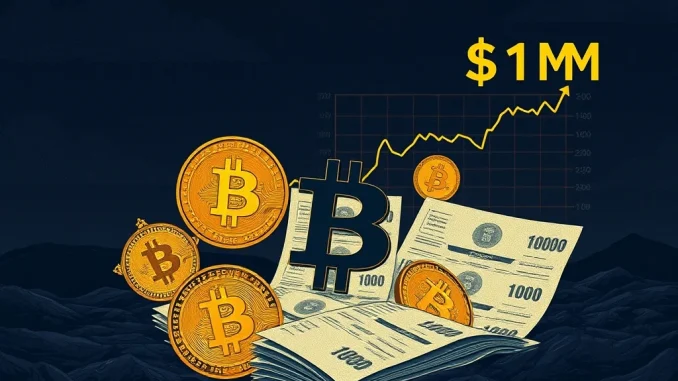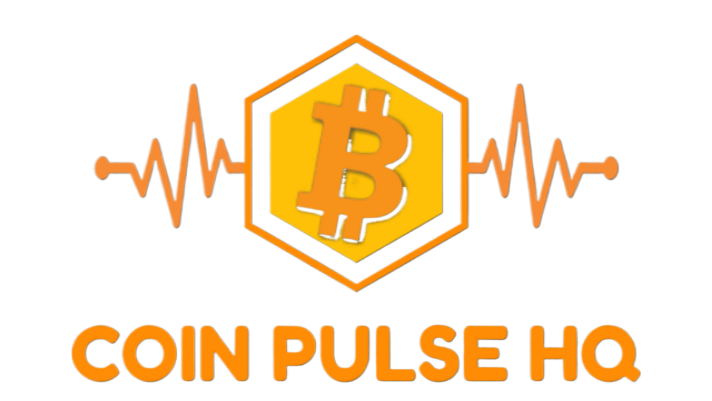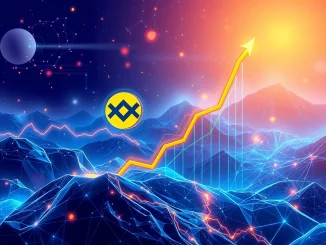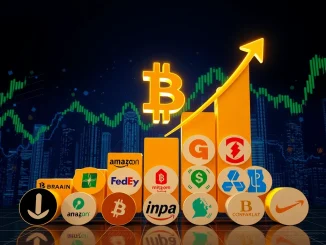
Have you ever looked at Bitcoin’s incredible journey and wondered why, despite all the hype and adoption, it hasn’t quite hit that mythical $1 million mark yet? Many in the crypto community feel a collective frustration, especially when they see institutional interest growing, yet the price doesn’t always reflect the underlying demand for actual Bitcoin. What if we told you there’s a widely discussed concept that might explain this phenomenon, often referred to as the ‘Paper Bitcoin Price Scam’?
What Exactly is ‘Paper Bitcoin’ and Why Does it Matter?
When you hear about ‘Paper Bitcoin,’ it’s not about physical Bitcoin printed on paper – that would be quite ironic! Instead, it refers to financial instruments that represent Bitcoin without requiring the holder to actually own the underlying digital asset. Think of it like owning shares in a gold ETF versus owning physical gold bars. While both might give you exposure to gold’s price movements, only one gives you direct custody of the physical commodity.
In the world of Bitcoin, ‘Paper Bitcoin’ typically includes:
- Bitcoin Futures Contracts: Agreements to buy or sell Bitcoin at a predetermined price on a future date. These are settled in cash, meaning no actual Bitcoin changes hands.
- Bitcoin Exchange-Traded Funds (ETFs) and Other Derivatives: Funds that track Bitcoin’s price, often holding futures contracts or synthetic positions, rather than spot Bitcoin.
- Fractional Reserve Practices: Some exchanges or custodians might not hold 1:1 Bitcoin for every user deposit, creating ‘phantom’ Bitcoin.
The core issue here is that these instruments create a market for ‘Bitcoin exposure’ without direct demand for the actual, scarce digital asset. This can lead to a disconnect between the perceived supply and demand in the broader market and the true supply and demand for real Bitcoin.
Is There a ‘Bitcoin Price Scam’ at Play?
The term ‘Bitcoin price scam’ might sound alarming, but it highlights a critical perspective on how traditional financial mechanisms can impact a decentralized asset. It’s not necessarily a direct, malicious conspiracy by a single entity, but rather a systemic effect of how these ‘paper’ markets operate. The argument is that by allowing large institutions and traders to bet on Bitcoin’s price without buying actual BTC, it dilutes the buying pressure on the spot market. If big money can short Bitcoin via futures without ever having to locate or borrow actual BTC, it creates an artificial supply that can suppress price discovery.
Consider these points:
- Diluted Demand: Every dollar invested in a Bitcoin futures ETF is a dollar that isn’t directly buying and removing actual Bitcoin from the circulating supply.
- Synthetic Supply: Futures markets can create the illusion of supply, even when the underlying asset is scarce. If someone sells a Bitcoin futures contract, they are effectively creating ‘paper Bitcoin’ supply.
- Institutional Leverage: Large players can use these derivatives to exert significant influence on price, potentially driving it down to cover short positions or accumulate at lower prices, without the complexities of handling real BTC.
This dynamic leads many to believe that the true, organic demand for Bitcoin is being masked or manipulated by these paper markets, preventing the price from reflecting its genuine scarcity and adoption.
Why Isn’t BTC $1M Yet? Connecting the Dots to the ‘Paper Bitcoin’ Phenomenon
The dream of a Bitcoin reaching $1 million is not just a pipe dream for many maximalists; it’s a valuation rooted in Bitcoin’s fixed supply and potential to become a global reserve asset. However, the prevalence of ‘Paper Bitcoin’ significantly complicates this trajectory. If a substantial portion of investment in Bitcoin-related products flows into derivatives rather than spot BTC, the direct upward pressure on the price of actual Bitcoin is diminished.
Imagine a scenario where millions of dollars flow into a Bitcoin ETF, but the ETF primarily holds cash-settled futures. This inflow doesn’t directly reduce the available supply of real Bitcoin. Contrast this with millions of dollars flowing into direct purchases of spot Bitcoin, which would reduce supply on exchanges and drive up the price due to fundamental supply-demand economics.
The ‘Paper Bitcoin’ ecosystem allows for:
- Unconstrained Shorting: It’s easier and less risky to short Bitcoin via futures than to short actual Bitcoin (which would require borrowing and returning the asset).
- Price Suppression: Persistent selling pressure from futures markets can act as a ceiling, preventing explosive price movements even when fundamental adoption is strong.
- Disguised Accumulation: Large entities might use these derivatives to manage their exposure while quietly accumulating spot Bitcoin off-market, or to drive prices down before buying.
This constant interplay, where ‘paper’ supply can be created and traded without affecting the fixed supply of real Bitcoin, is a major reason why the BTC $1M prediction, while theoretically sound based on scarcity, faces significant headwinds in the current market structure.
Understanding Bitcoin’s True Valuation Beyond the Paper Market
Despite the influence of ‘Paper Bitcoin,’ it’s crucial to remember what gives Bitcoin its fundamental strength and why its long-term Bitcoin valuation remains incredibly high for many. Bitcoin’s true value comes from its:
- Absolute Scarcity: Only 21 million Bitcoins will ever exist. This fixed supply is a powerful economic force.
- Decentralization: No single entity controls Bitcoin, making it resistant to censorship and manipulation in its purest form.
- Network Effects: The growing number of users, developers, and businesses building on Bitcoin’s network strengthens its utility and security.
- Sound Money Principles: Predictable inflation schedule, unconfiscatable nature (with self-custody), and global accessibility.
These intrinsic qualities are what drive the long-term bullish case for Bitcoin. The ‘Paper Bitcoin’ market doesn’t change these fundamentals; it merely complicates the short-to-medium term price discovery process. Investors who understand this distinction often advocate for holding actual, self-custodied Bitcoin rather than relying solely on derivative products.
What Can You Do in a Market Influenced by ‘Paper Bitcoin’?
Navigating a market potentially influenced by crypto market manipulation can be challenging, but there are actionable insights you can take:
- Prioritize Self-Custody: If you believe in Bitcoin’s true value, holding your own private keys ensures you own real Bitcoin, not a derivative or an IOU. This removes your Bitcoin from the ‘paper’ supply.
- Educate Yourself: Understand the difference between spot markets, futures, and other derivatives. Knowledge is your best defense against market FUD and misdirection.
- Long-Term HODLing: For many, the long-term investment thesis for Bitcoin remains strong, regardless of short-term price fluctuations caused by ‘paper’ markets. Time in the market often beats timing the market.
- Demand Transparency: Support exchanges and platforms that offer proof-of-reserves and operate with full transparency regarding their Bitcoin holdings.
While the concept of a ‘Paper Bitcoin Price Scam’ might seem daunting, it underscores the importance of understanding the mechanics behind the scenes. It’s a call to look beyond the daily price charts and focus on Bitcoin’s foundational strengths.
The Unyielding Power of Real Bitcoin
The frustration around why Bitcoin hasn’t hit that elusive $1 million mark is understandable, especially when considering the significant influence of ‘Paper Bitcoin’ and potential crypto market manipulation. These derivative markets, while offering liquidity and institutional access, can create a disconnect from Bitcoin’s fundamental scarcity. However, the ‘Bitcoin price scam’ narrative serves as a powerful reminder that true Bitcoin value lies in its decentralized, finite nature, not in synthetic representations. By understanding these dynamics and prioritizing direct ownership, investors can align themselves with the unyielding power of real Bitcoin, safeguarding their position in the long game towards its ultimate potential.
Frequently Asked Questions (FAQs)
Q1: What is the main difference between ‘Paper Bitcoin’ and real Bitcoin?
The main difference is ownership and custody. ‘Paper Bitcoin’ refers to financial instruments like futures or ETFs that give you price exposure to Bitcoin but do not grant you direct ownership of the underlying BTC. Real Bitcoin means you hold the actual digital asset in a wallet where you control the private keys.
Q2: How does ‘Paper Bitcoin’ affect the BTC price?
‘Paper Bitcoin’ can suppress the price of real Bitcoin by diluting demand for the spot asset and creating synthetic supply. When large investments flow into derivatives instead of direct Bitcoin purchases, it reduces the upward pressure on the spot price, making it harder for Bitcoin to reach higher valuations like the BTC $1M prediction.
Q3: Is the ‘Paper Bitcoin Price Scam’ a conspiracy?
The term ‘Bitcoin price scam’ is more of a critical observation of systemic market dynamics rather than a literal conspiracy by a single group. It describes how traditional financial structures and derivative markets can inadvertently or intentionally influence Bitcoin’s price discovery, preventing it from fully reflecting its scarcity and true demand.
Q4: What are the risks of investing in ‘Paper Bitcoin’ products?
Risks include counterparty risk (the institution holding the assets), lack of true ownership, and potential for the price of the derivative to diverge from the spot price of Bitcoin. You also miss out on the full benefits of decentralization and self-custody that come with holding real Bitcoin.
Q5: How can I protect myself from the effects of ‘Paper Bitcoin’ and crypto market manipulation?
To mitigate the effects, prioritize self-custody of your Bitcoin, educate yourself on market structures, and consider a long-term ‘HODLing’ strategy. Supporting transparent exchanges and demanding proof-of-reserves can also help promote healthier market practices.
Q6: Does ‘Paper Bitcoin’ mean Bitcoin can never reach $1M?
No, it doesn’t mean Bitcoin can never reach $1M. It simply suggests that the presence and influence of ‘Paper Bitcoin’ create significant headwinds and make the journey longer or more volatile. The fundamental scarcity and increasing adoption of Bitcoin still provide a strong long-term case for high valuations, but these derivative markets add layers of complexity to price discovery.



